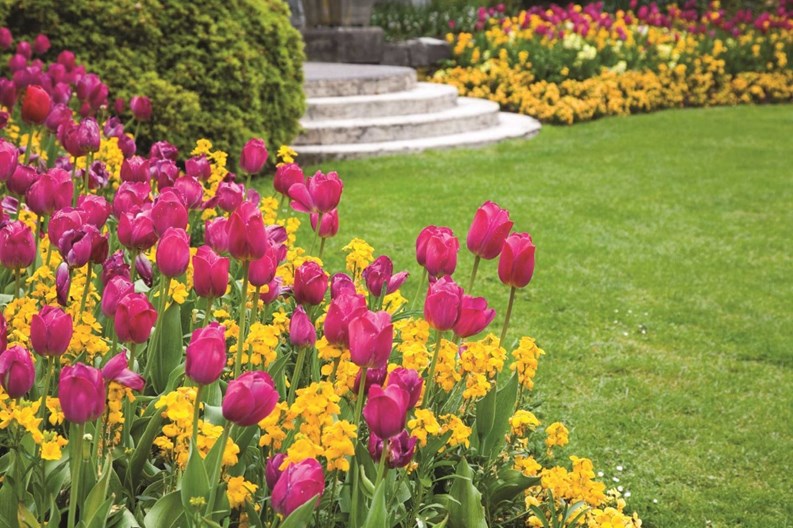Spring is here, which means the sky is blue, the grass is green, and the flowers will be blooming—that is, if you plant them. From knowing which plants do best in which location to keeping up with everyday care and maintenance, keeping your condo or co-op property looking nice can be hard work, but worth every minute and dime spent in the end. And with some extra knowledge from the inside, not only can properties uphold a high level of aesthetics, the endeavor can be cost-effective, even in this day in age.
What Are The Plants?
Plants are everywhere around us, but like everything else in the world, they have their time and place. It’s highly unlikely to see palm trees lining the streets of northern New Jersey, and it would be a foolish board indeed who insisted that their landscaper plant any on their property. When it comes to deciding what kinds of flowers to plant on your own grounds or flowerbeds, it's vital to consider which species will flourish in a waterfront or inland environment, and which may not.
The two basic categories of flowering flora are perennials and annuals. Perennials are planted once and bloom again on their own season after season, whereas annuals die off after one growth cycle and must be replaced each year.
Raymond Engel, owner of Sierra Landscape in Haskell says that while annuals only live for one season, they make quite an impression, with lots of color and variety. Areas such as the main entrance sign and clubhouse benefit from annuals because they create a tremendous accent.
“Annuals give you immediate color, it’s such a dynamic display,” agrees Bruce Hellerick, senior horticulturalist of The Brickman Group in Monmouth Junction. “Its goal is to grow, flower, set seed and die.” This usually takes anywhere from a few weeks to a month, with some exceptions.
Nelson Lee, president of Landscape Works in Wyckoff adds that needing to change them out every season might be tedious but it allows for variety and if you use smaller annuals the expense could be kept down.
“It’s great to install them as long as people are patient enough to let them grow,” he concludes.
But, he does admit that they are the more expensive option and require tremendous care because they’re more delicate than their perennial counterparts.
According to Hellerick, perennials are the plants that live more seasons because the roots live and re-bloom for years. “The reason people are using perennials more and more is because it’s a one-time cost,” Hellerick says. “But they’re not zero maintenance. They need to be cleaned up every year, cut back, and every three years or so they should be divided and moved.”
Hellerick and Lee both point out the disadvantages that come with having perennials is the possibility of damage from wildlife such as deer. Lee adds that in the winter, the foliage disappears, and that the initial installation cost of them can be more expensive than for annuals.
The Right Plant in the Right Place
Though most flowers get planted in flowerbeds and decorative planters, your HOA certainly doesn't need to limit itself to just those kinds of arrangements. Window boxes, terraced landscaping elements, and hanging baskets are just a few of the other ways your building or association can incorporate live flowers into its visual program. An apartment complex is a blank canvas when it comes to vegetation, but as we said before, everything has its place. You need to make sure that your flowers are planted in such a way that they get the appropriate amount of water, aren’t crowded, and get the right amount of sunlight.
According to Lee, there’s a hierarchy of considerations to account for in order to give your flowers the best chance for a long, beautiful life. It includes figuring out the best soil and optimal lighting conditions for your plants, their budget and maintenance schedules, and of course, your own community members' aesthetic preferences.
Hellerick seconds Lee's focus on soil quality and preparation. “Just like painting a wall which needs to be stripped, sanded and primed, you need to prepare your soil properly,” he says. “In a container where someone would keep annuals, for instance, the soil needs to be porous enough for the water to drain.” Topsoil would be too heavy, so Hellerick suggests using a premade mix of soil specifically formulated for containers.
Lighting is another big factor when planting flowers. As a rule of thumb, Lee says that perennials tolerate heavier shade while annuals need more sunlight. Flowers such as marigolds, petunias, begonias, salvias, and vincas need full sun. Impatiens can only tolerate part shade, and browallias, hostas and bergenias need heavier shade.
As for when to plant, Lee says there are four times a year that plants should go in: early spring, early summer, fall and late fall in preparation for early spring.
“A lot of people want to plant flowers before Memorial Day Weekend,” adds Hellerick. This is fine as long as your plants can survive any freak temperature variations. Petunias, for example, will tolerate cold. Other plants such as vincas only tolerate warm, tropical-like climates and so planting them before June would be unwise.
According to Lee, other flowers such as impatiens, marigolds and begonias need to be planted in the early summer. Mums and cabbage are for the fall and bulbs for tulips and daffodils are put in the late fall to bloom in the spring.
Hellerick says that it’s all about the grouping of your plants that affects the general impact. He says that tall plants should be placed in the back of a display and shorter ones in front. He also says to try and pick plants that have interesting foliage.
Lee says that there are always certain areas in condo communities that are focused on such as the main entrance and clubhouse, but that he’s also come across complexes that do something as simple as scattering pots around to add a little something extra.
Plant Maintenance
In addition to the traditional maintenance of keeping things clean and in the right light, there are many factors to keep your plants healthy. Mulching is one of them. Engel says that mulching should take place every year as it adds a fresh look to the entire complex and mulch adds protection for plants by stabilizing the soil in the winter and the summer.
Lee agrees saying that some complexes mulch twice a year because they simply like the way fresh mulch looks. Mulching, he says, should be done in the spring. He adds that the most popular mulch is ground hardwood because it’s the least expensive with dyed or colored mulch coming in a close second for aesthetic reasons.
Popularity aside, some pros aren't big fans of hardwood mulch. “It rots the nutrients from flowers,” Hellerick says. He suggests using compost instead.
Lee says that not mulching at all isn’t good for the plants, but he and Engel both agree that one of the biggest issues they encounter is people using far too much mulch, which will eventually suffocate and kill the plant.
Water is also crucial to robust good health when it comes to flowers.
“Many people water their plants for 15 minutes and think that’s enough,” says Hellerick. But you have to stick your fingers in the soil and see if it’s moist below the surface.
Boards and Landscapers Working Together
In this day in age, cuts are being made everywhere in organization budgets. There are mixed views if cuts are being made when it comes to landscaping at condos and co-ops.
Engel says that communities are definitely cutting back, especially with annuals that require replanting (and thus re-purchasing) every year.
“Perennials are the way to go when on a budget,” he says. “You can put ten new plants in a year and eventually you’ll end up with a really nice garden.”
Hellerick says that HOAs are not cutting back on floral displays drastically, but that they are consolidating and finding ways to streamline their vegetation. For instance, instead of having 30 small flowerbeds littered around their property, Hellerick says an association might cut down to 12 beds and make them slightly bigger. Additionally, he says his clients are making better use of any space that is available.
“Many times they have big open spaces of turf not being used and it gets turned into a grassy meadow,” which, Hellerick says, is a nice concept.
Hellerick says that boards have a lot of knowledge when it comes to landscaping from past experiences of owning a home, but that they don’t necessarily look at the commercial aspect of vegetation at a condo or co-op. “They want to put flowers all over the place, which costs more,” he says, adding that boards should look to professionals for opinions to get the most impact out of their displays.
Engel says that when projects are left to communities without any supervision, problems can arise when plants aren’t planted in the right lighting or when the mature size of a plant isn’t taken into consideration.
“You have a plant that starts out in a one-gallon container and it’s not that big, but eventually it’ll grow into a four-foot wide plant,” he says, citing how many complexes end up with “jungles” because the appropriate precautions weren’t taken. “Once you end up with a mistake, you have to divide and replant,” he says.
Hire a Pro
Engel agrees that communities should reach out to professionals, but to do it carefully. “Some landscape communities are all about the bottom line,” he says. “All they want to do is upsell.” An association has to find a landscape firm that is truly dedicated to its well-being.
“We work with them to fix their budget,” Engel says, stating that the firm has to be on board with the association’s goals, which the association has to make clear, and work within the budget.
Lee agrees saying that the committee has to be transparent about what they want in terms of budget and vegetation. Their best option is to seek out competing bids, check references of firms, make sure that specifications are met for contract and that the board ends up satisfied with how the community looks.
“You get what you pay for,” he says, citing that if an one firm offers a proposal that is way cheaper than another firms, it’s the committee’s responsibility to know exactly what services will be offered.
Lee concludes that landscaping is the most expensive yearly budget item after regular maintenance to structures and buildings at condos and HOAs, but that associations still don’t mind shelling out the money for it.
“It gives off the first impression, which is most important,” he concludes.
Bernadette Marciniak is a freelance writer and a frequent contributor to The New Jersey Cooperator.






Leave a Comment